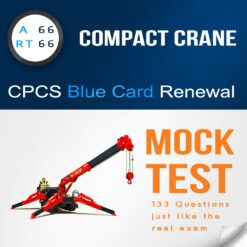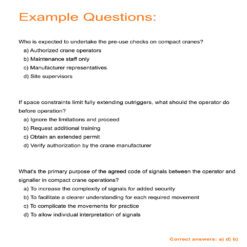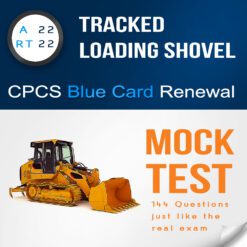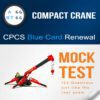RT66 CPCS Blue Card Renewal Mock Test with 133 Questions and Answers / A66 Compact Crane
£15.00 Original price was: £15.00.£9.95Current price is: £9.95.
Pass with Flying Colors: Realistic Practice Questions for Compact Crane CPCS Blue Card Renewal!
- Questions & Answers: based on the latest RT 66 Compact Crane – CPCS Renewal Test Revision FACTSHEET
- Categories: A66 – Compact Crane
- Number of Multiple-choice Questions: 133
- Format: PDF
- Delivery time: Instant download after checkout
- Refunds: No refunds once downloaded, unless you ordered duplicates by mistake.
If there are any issues with your download, please email CardRenewalTest@gmail.com and we’ll send it ASAP
Prepare for Success: Your Ultimate Guide to CPCS Blue Card Renewal with RT66 Compact Crane Mock Practice Test
Renew Your CPCS Blue Card with Confidence
Are you a dedicated operator of spider cranes or other variants of the RT66 Compact Crane, looking to extend your CPCS Blue Card for another five years? The CPCS renewal test can be a challenging but necessary step in ensuring you continue to operate your equipment safely and effectively. Our latest offering, the RT66 Compact Crane CPCS Blue Card Renewal Mock Practice Test, has been meticulously crafted to aid you in passing the test with ease.
Why You Need Our Mock Practice Test
Tailored Mock Questions for Success
Our comprehensive set of 133 multiple-choice questions is based on the latest NOCN CPCS RT66 Compact Crane factsheet. These questions mirror the format and content of the actual exam, allowing you to practice and familiarize yourself with the specific concepts, scenarios, and regulations you’ll encounter.
Efficient Preparation, No Need to Read Lengthy Texts
We understand that studying extensive textual content might not be everyone’s preferred method. Our mock practice test provides a structured and concise way to grasp crucial information. You’ll get clear, concise questions and answers, designed to help you absorb essential facts without overwhelming you.
Practical Relevance for Real-World Scenarios
The questions focus on practical aspects, emphasizing real-life situations you might encounter in your day-to-day operations. This practical focus allows you to apply your knowledge effectively on the job, making you not just a test-passing candidate but a safer and more skilled crane operator.
What You’ll Learn
- Insights on compact cranes’ technical specifications, capacities, and variants.
- Proper pre-use checks and necessary inspections for safe operations.
- Understanding lift plans and communicating effectively with lift planners.
- Maneuvering and operating in varied work environments and conditions.
- Managing stability, wind conditions, and risk assessment for safe working at heights.
- Ensuring safe lifting practices, load calculations, and RCI (Rated Capacity Indicator) functions.
- Practical steps to avoid incidents or accidents and maintain overall safety during operations.
How to Pass the CPCS Blue Card Renewal Test
- Practice, Practice, Practice: Regularly test your knowledge using our comprehensive mock practice test. Repetition helps solidify essential information.
- Understand the Concepts: Don’t just memorize answers; understand the reasoning behind them. It’ll better equip you to handle real scenarios effectively.
- Time Management: Simulate test conditions and practice time management while answering questions to improve your speed and accuracy.
- Review and Reinforce: Make use of the explanations provided with answers to reinforce your understanding and address any areas you find challenging.
Conclusion
Renewing your CPCS Blue Card for operating RT66 Compact Cranes is not just about passing a test. It’s about ensuring that you continue to operate this equipment safely and competently. Our RT66 Compact Crane CPCS Blue Card Renewal Mock Practice Test equips you with the tools and knowledge needed to confidently navigate the test and continue your journey as a competent, skilled, and safe crane operator.
As a bonus, here’s a summary of the key points from the official RT66 Compact Crane factsheet:
Preparation and Completing Work (Preparation):
- Understanding Compact Cranes: They cover a range of cranes with a lift capacity of up to 10 tonnes, including various mounted and chassis options.
- Operator Responsibility: Proper pre-use checks are essential for safe operation; operators need to be trained and certified.
- Lift Planning: A legislative requirement, lift plans must identify risks, mitigating measures, sequence of work, and personnel involved.
- Arriving at the Site: Crane’s access routes need to be clear of hazards, and operators must identify and inform about potential obstructions.
Lifting Practices and Working with Others (Working Tasks):
- Outriggers and Stability: Some cranes have stabilizers; it’s crucial to lower the boom after work and understand lifting capacities.
- Lift Plan Adjustments: If there are concerns or errors in the lift plan, only the appointed person can amend it.
- Lifting Conditions: Complicated factors such as lifting in confined spaces and wind conditions need to be considered.
- Safety Around Workers: Operations should avoid lifting loads above other workers or pedestrians, implementing necessary protections.
Working Safely and at Height (Working at Height):
- Safety Guidelines: Overhead power line distances, wind speed limitations, and lifting conditions need close attention.
- Cranes’ Leveling: Compact cranes must be level both longitudinally and laterally to prevent instability.
- Handling Suspended Loads: Caution is advised while slewing loads and avoiding lateral stress on booms or jibs.
- Additional Personnel Safety: A code of signals is essential for communication between the operator and the signaller.
- Working Near Edges: Safety measures, including fall restraint or arrest equipment, are necessary when working near edges.
Stability:
- Ground and Base Evaluation: Stability relies on ground and base strength, especially when the crane is expected to support loads.
- Environmental Changes: Changes in the ground, especially due to heavy rain or structure modifications, must be considered.
- Outrigger Handling: Use of spreader mats and maintaining specific distances from edges is crucial to reduce applied pressure.
This summary covers essential points from the RT66 Compact Crane factsheet, focusing on preparation, safe practices, and maintaining stability. Understanding these points is crucial for operators in maintaining safety and operational efficiency.
1 review for RT66 CPCS Blue Card Renewal Mock Test with 133 Questions and Answers / A66 Compact Crane
Add a review Cancel reply
Related products
CPCS Blue Card Renewal Tests
RT22 CPCS Blue Card Renewal Mock Test with 144 Questions and Answers / A22 Tracked Loading Shovel
CPCS Blue Card Renewal Tests
RT17 CPCS Blue Card Renewal Mock Test with 144 Questions and Answers / A17 Telescopic Handler
CPCS Blue Card Renewal Tests
RT39 CPCS Blue Card Renewal Mock Test with 140 Questions and Answers / A39 Skip Handler
CPCS Blue Card Renewal Tests
RT40 CPCS Blue Card Renewal Mock Test with 139 Questions and Answers / A40 Slinger Signaller
CPCS Blue Card Renewal Tests
CPCS Blue Card Renewal Tests
RT12 CPCS Blue Card Renewal Mock Test with 130 Questions and Answers / A10, A12 Excavator 180°
CPCS Blue Card Renewal Tests
RT33 CPCS Blue Card Renewal Mock Test with 129 Questions and Answers / A33 Agricultural Tractor
CPCS Blue Card Renewal Tests

















Jack –
I’m a bit oldschool and would have preferred an actual book. But this will do just fine. There’s the benefit of being able to read on your phone from anywhere.